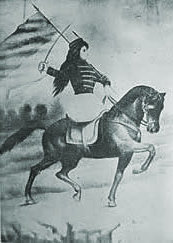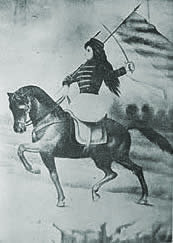
|
Women and Independence in Latin America An exploration of women's involvement in the Latin American Wars of Independence |

|

|
Women and Independence in Latin America An exploration of women's involvement in the Latin American Wars of Independence |

|
Other names: Buros, Buroz
Gender:Female
Ethnic origen: Unknown
Events:
| 1796 | - | Tacarigua de Mamporal | - | Not applicable | - | She was born in Tacarigua de Mamporal, Barlovento. |
| 1812 | - | Venezuela | - | Unknown | - | She married Juan José Velázquez. |
| 1813 | - | Río Chico | - | Patriot | - | She was captured by royalists. |
| 1813 | - | Caracas | - | Unknown | - | She took refuge at her aunt's house here in 1813. |
| 1813 | - | Haiti | - | Unknown | - | She possibly fled here after being captured in 1813. |
| 1814 | - | Venezuela | - | Unknown | - | Her husband, Juan José Velázquez was killed by the Spaniards. |
| 1814 | - | Cartagena | - | Unknown | - | She fled here in 1814. |
| 1815 | - | Cumaná | - | Unknown | - | She went to look for her husband, Juan José Velázquez here in 1815. |
| 1815-1816 | - | Cumaná | - | Unknown | - | She took refuge in Cumaná from 1815-1816. |
| 1816 | - | Barcelona | - | Unknown | - | She married Colonel Chamberlain. |
| 1817 | - | Barcelona | - | Unknown | - | She was killed on 7 April 1817 by Spanish soldiers. |
| 1817 | - | Barcelona | - | Unknown | - | She lived here with her husband, Colonel Chamberlain in 1817. |
Connections:
Ramos, EulaliaBiography:
She is sometimes referred to as Eulalia Buros or Buroz.
The daughter of a patriotic republican family, she was born in Venezuela in 1796 and married at 16. She fled into the woods to escape persecution. There she gave birth to a daughter who died shortly afterwards. She was captured in 1813, but escaped to Cartagena and Haiti. Her second husband (Coronel Chamberlain?) shot himself in a convent where they were hiding with 1400 other patriots. She then shot a Spanish official and was killed, her body mutilated and dragged by a horse. (Knaster, 479-80.)
In 1813, her husband, Juan José Velázquez fled from political persecution, she, too, sought refuge in Río Chico. She took her 40-day-old daughter, and hid in the mountains for a few days, but her daughter died. She reached Río Chico, and left her house to visit a friend and suddenly found herself in the middle of a Spanish battalion, led by a local officer, by his side a tall, black woman named Lorenza. Lorenza attacked Ramos Sánchez who screamed for help, then lost consciousness. The soldiers were about to kill her when a bugle announced the arrival of patriots. Ramos Sánchez was taken to her house where her friends took care of her. Hearing of her suffering, Ramos Sánchez's aunt in Caracas, Josefa Pía, took her in. In 1814, when Bolívar went into exile, they all left for Cartagena. Velázquez was discovered by Lorenza's Spanish officer lover, who demanded that Velázquez tell them where Ramos Sánchez was. He refused to say, and was shot and killed.
Ramos Sánchez was concerned at the lack of news from her husband and went to Cumaná for news. There she learned of his death and took refuge in his father's house. She remained there until 1816 when she met and later married Bolívar's aide, Coronel Enrique Chamberlain. They lived in Barcelona, Eastern Venezuela, in the "Casa Fuerte". On 7 April 1817 the Spanish army occupied Barcelona. The population took refuge in the San Francisco convent, which was defended by the patriotic army. Ramos Sánchez, Chamberlain and several women were in a cell. The Spanish army broke in and took Chamberlain away. Ramos Sánchez managed to retain a pistol. She heard the shot that killed Chamberlain. A Spanish officer offered to save her, telling her to shout "Viva España, mueran los patriotas". Instead she cried "Viva la Patria, mueran los tiranos" and shot the officer dead. She was then shot dead by the Spanish soldiers who took her jewels and mutilated her body. (N.A., Heronías, 19-21)
She saw her husband, Enrique Chamberlain, shoot himself, she then took his other gun and killed a Spanish official. She was around 300 prisoners who were then killed on 7 April 1817. (Monsalve, 78)
Brown states that Charles William Chamberlain was a protestant adventurer who was in command of Barcelona fort when it was attacked by royalists in 1816. As the royalists took the fort Chamberlain, a "patriotic foreigner", killed Ramos and then committed suicide. Chamberlian "preferred to end her life rather than let her live dishonoured by Spaniards." (Brown, 68)
References:
Brown, Matthew (2006) Adventuring through Spanish Colonies: Simón Bolívar, Foreign Mercenaries and the Birth of New Nations
Knaster, Meri (1977) Women in Spanish America: An Annotated Bibliography from Pre-Conquest to Contemporary Times
Monsalve, José D (1926) Mujeres de la independencia
N.A. (1964) Heroínas venezolanas